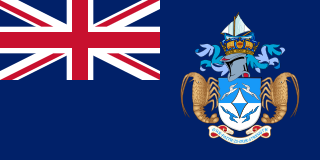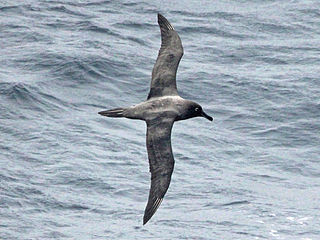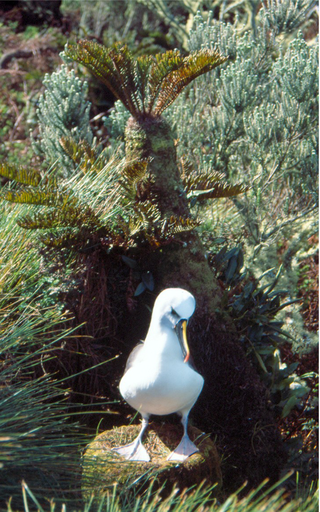
Tristan da Cunha, colloquially Tristan, is a remote group of volcanic islands in the South Atlantic Ocean. It is the most remote inhabited archipelago in the world, lying approximately 2,787 kilometres (1,732 mi) from Cape Town in South Africa, 2,437 kilometres (1,514 mi) from Saint Helena, 3,949 kilometres (2,454 mi) from Mar del Plata in Argentina, South America and 4,002 kilometres (2,487 mi) from the Falkland Islands.

The Inaccessible Island rail is a small bird of the rail family, Rallidae. Endemic to Inaccessible Island in the Tristan Archipelago in the isolated south Atlantic, it is the smallest extant flightless bird in the world. The species was described by physician Percy Lowe in 1923 but had first come to the attention of scientists 50 years earlier. The Inaccessible Island rail's affinities and origin were a long-standing mystery; in 2018 its closest relative was identified as the South American dot-winged crake, and it was proposed that both species should be nested within the genus Laterallus.

Gough Island, also known historically as Gonçalo Álvares, is a rugged volcanic island in the South Atlantic Ocean. It is a dependency of Tristan da Cunha and part of the British overseas territory of Saint Helena, Ascension and Tristan da Cunha. It is about 400 km (250 mi) south-east of the Tristan da Cunha archipelago, 2,400 km (1,500 mi) north-east from South Georgia Island, 2,700 km (1,700 mi) west from Cape Town, and over 3,200 km (2,000 mi) from the nearest point of South America.

Inaccessible Island is a volcanic island located in the South Atlantic Ocean, 31 km (19 mi) south-west of Tristan da Cunha. Its highest point, Swale's Fell, reaches 581 m (1,906 ft), and the island is 12.65 km2 (4.88 sq mi) in area. The volcano was last active six million years ago and is currently extinct.

Nightingale Island is an active volcanic island in the South Atlantic Ocean, 3 square kilometres (1.2 sq mi) in area, part of the Tristan da Cunha group of islands. They are administered by the United Kingdom as part of the overseas territory of Saint Helena, Ascension and Tristan da Cunha.

The sooty albatross is a species of marine bird belonging to the albatross family Diomedeidae. It is a medium-sized albatross that sports a sooty-brown or sooty-black color. It can be found in the southern Atlantic Ocean, the southern Indian Ocean, and the Southern Ocean. This bird scavenges for squid, fish, and carrion. Like other albatrosses, these birds mate for life and return to the same breeding spots every season. A single pair will mate every other year on a variety of islands in the southern Atlantic Ocean and the southern Indian Ocean islands. This bird is an endangered species and conservation efforts are taking place.

The Atlantic yellow-nosed albatross is a large seabird in the albatross family Diomedeidae.
Saint Helena, Ascension Island and Tristan da Cunha, as well the other uninhabited islands nearby, are a haven for wildlife in the middle of the Atlantic Ocean. The islands are or were home to much endemic flora and fauna, especially invertebrates, and many endemic fish species are found in the reef ecosystems off the islands. The islands have been identified by BirdLife International as Important Bird Areas for both their endemic landbirds and breeding seabirds.
Agrostis media is a species of grass in the family Poaceae. It is found only in Tristan da Cunha. Its natural habitats are subantarctic shrubland, subantarctic grassland, rocky areas, and rocky shores.
Agrostis trachychlaena is a species of grass in the family Poaceae. It is endemic to Inaccessible and Nightingale Islands, Tristan da Cunha. Its natural habitat is subantarctic grassland.

Wilkins's finch, also known as Wilkins's bunting or the grosbeak bunting, is a species of bird in the family Thraupidae. It is restricted to Inaccessible Island and Nightingale Island of the Tristan da Cunha archipelago, part of the British overseas territory of Saint Helena in the South Atlantic Ocean. Its natural habitats are temperate shrubland and subantarctic grassland.

The Gough finch or Gough bunting, is a critically endangered species of songbird.
Atriplex plebeja is a species of plant in the family Amaranthaceae. It is endemic to Tristan da Cunha, including Inaccessible and Nightingale Islands. Its natural habitat is rocky shores. It is threatened by habitat loss.
Carex thouarsii is a species of sedge found in the Tristan da Cunha archipelago. It lives chiefly in heaths dominated by Blechnum palmiforme, and Phylica arborea woodland. It is widespread and common on Tristan da Cunha and Inaccessible Island, but scarce on Nightingale Island, possibly due to a lack of habitat. It was first described by Dugald Carmichael in 1819 following the British annexation of Tristan da Cunha in 1816.
Rostkovia tristanensis is a species of flowering plant in the family Juncaceae, the rushes. It is endemic to Tristan da Cunha, where it occurs only on the main island and Gough Island. It grows in heath habitat with Empetrum. It is not uncommon on Gough Island, but it is rarely seen in flower.
Scirpus bicolor is a species of plant in the sedge family, Cyperaceae. The plant is endemic to Tristan da Cunha, Nightingale Island, Inaccessible Island and Gough Island. Its natural habitats are subantarctic forests, subantarctic shrubland, and swamps.

The northern rockhopper penguin, Moseley's rockhopper penguin, or Moseley's penguin is a penguin species native to the southern Indian and Atlantic Oceans. It is described as distinct from the southern rockhopper penguin.

Tristan da Cunha is an archipelago of five islands in the southern Atlantic Ocean, the largest of which is the island of Tristan da Cunha itself and the second-largest, the remote bird haven, Gough Island. It forms part of a wider territory called Saint Helena, Ascension and Tristan da Cunha which includes Saint Helena and Ascension Island.

The Nightingale Island finch is a species of bird in the family Thraupidae.

The Tristan da Cunha–Gough Islands shrub and grasslands is a terrestrial ecoregion which covers the Tristan da Cunha archipelago and Gough Island in the South Atlantic Ocean. The islands' remote location gave rise to many endemic species.












